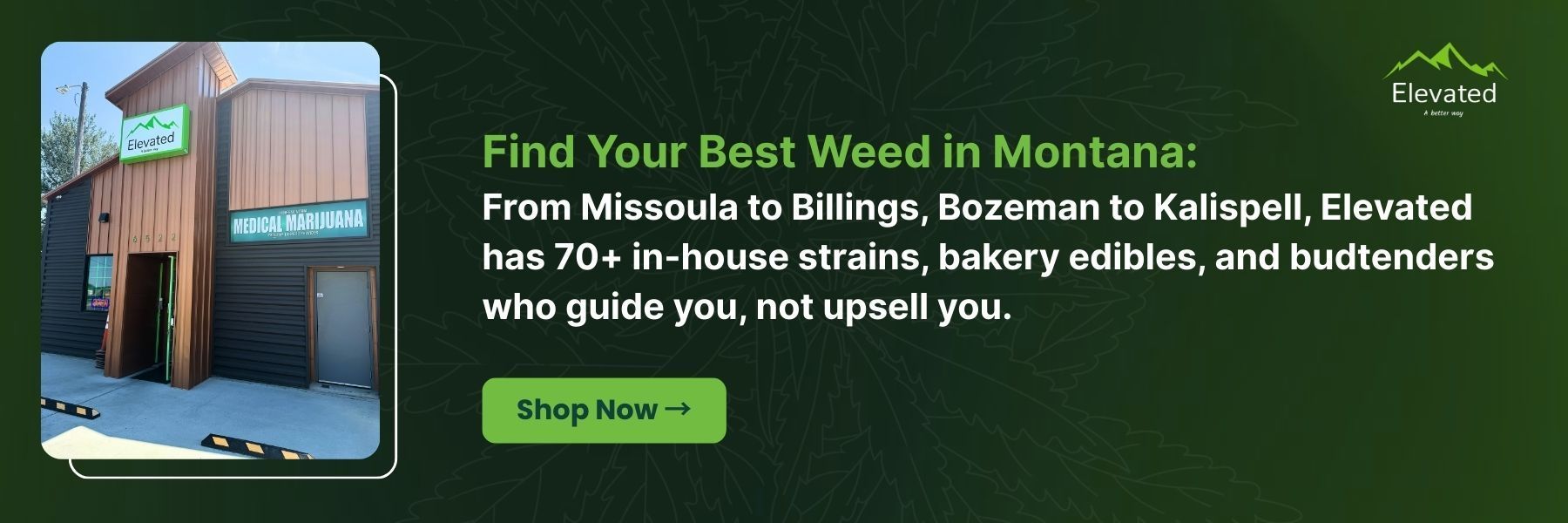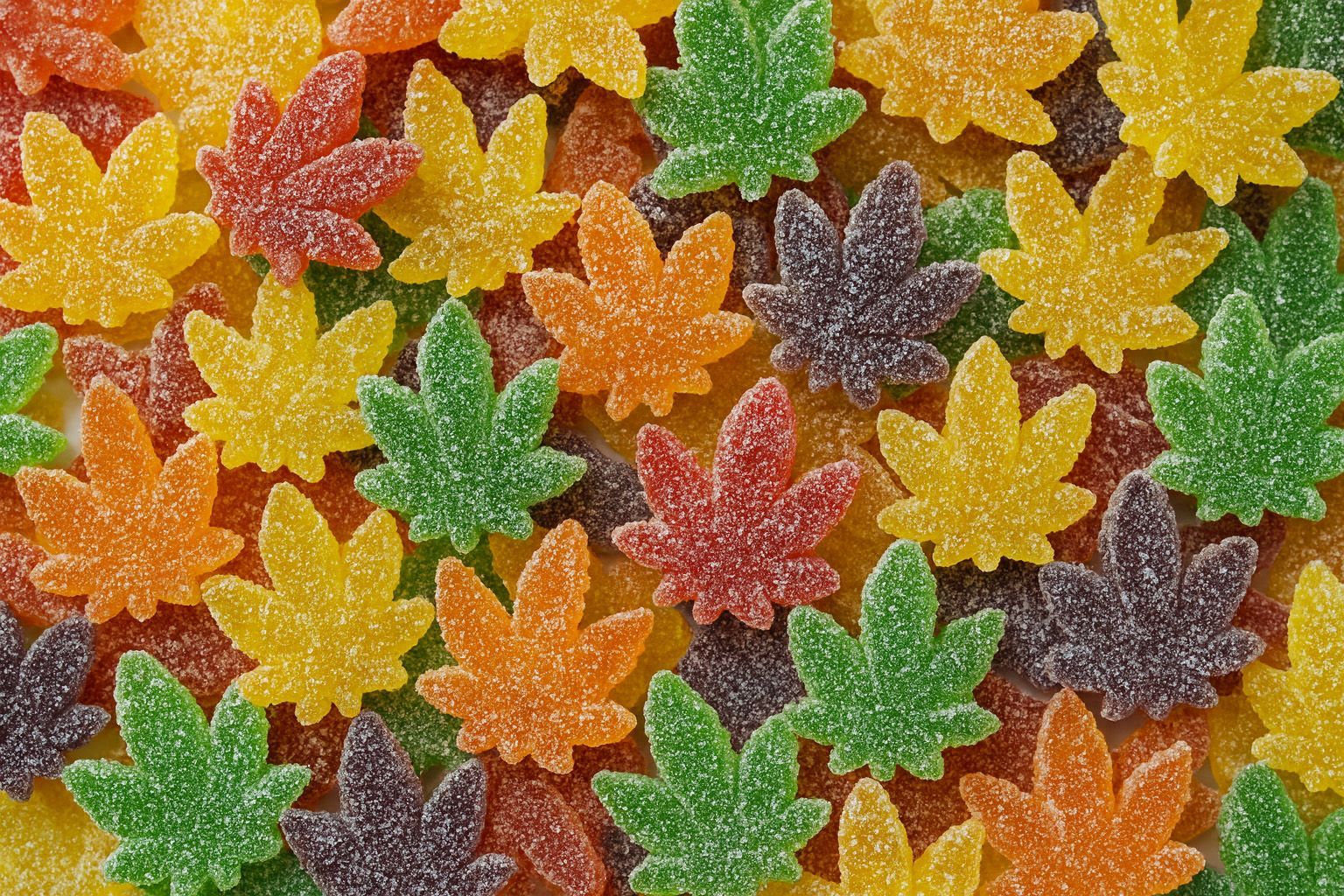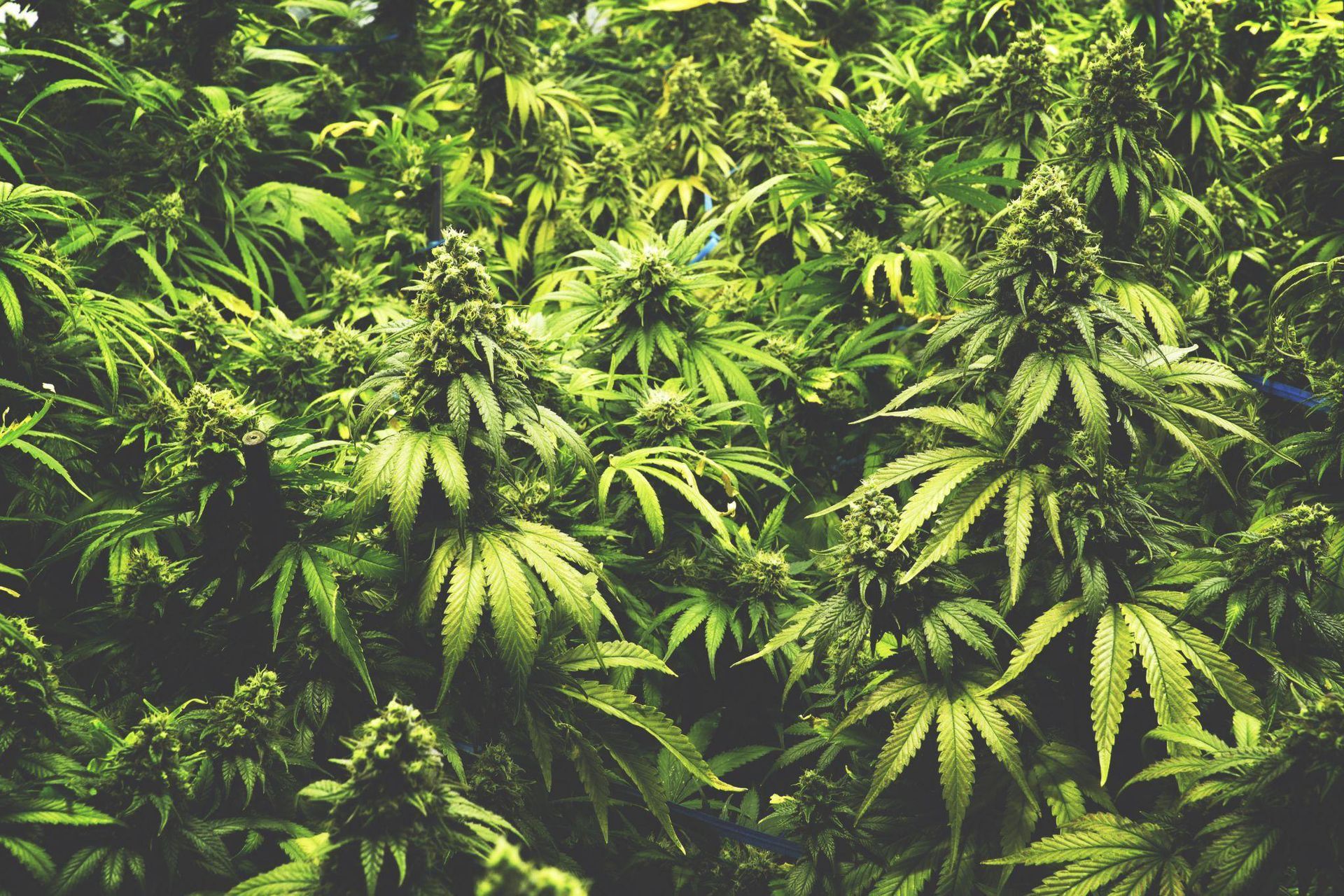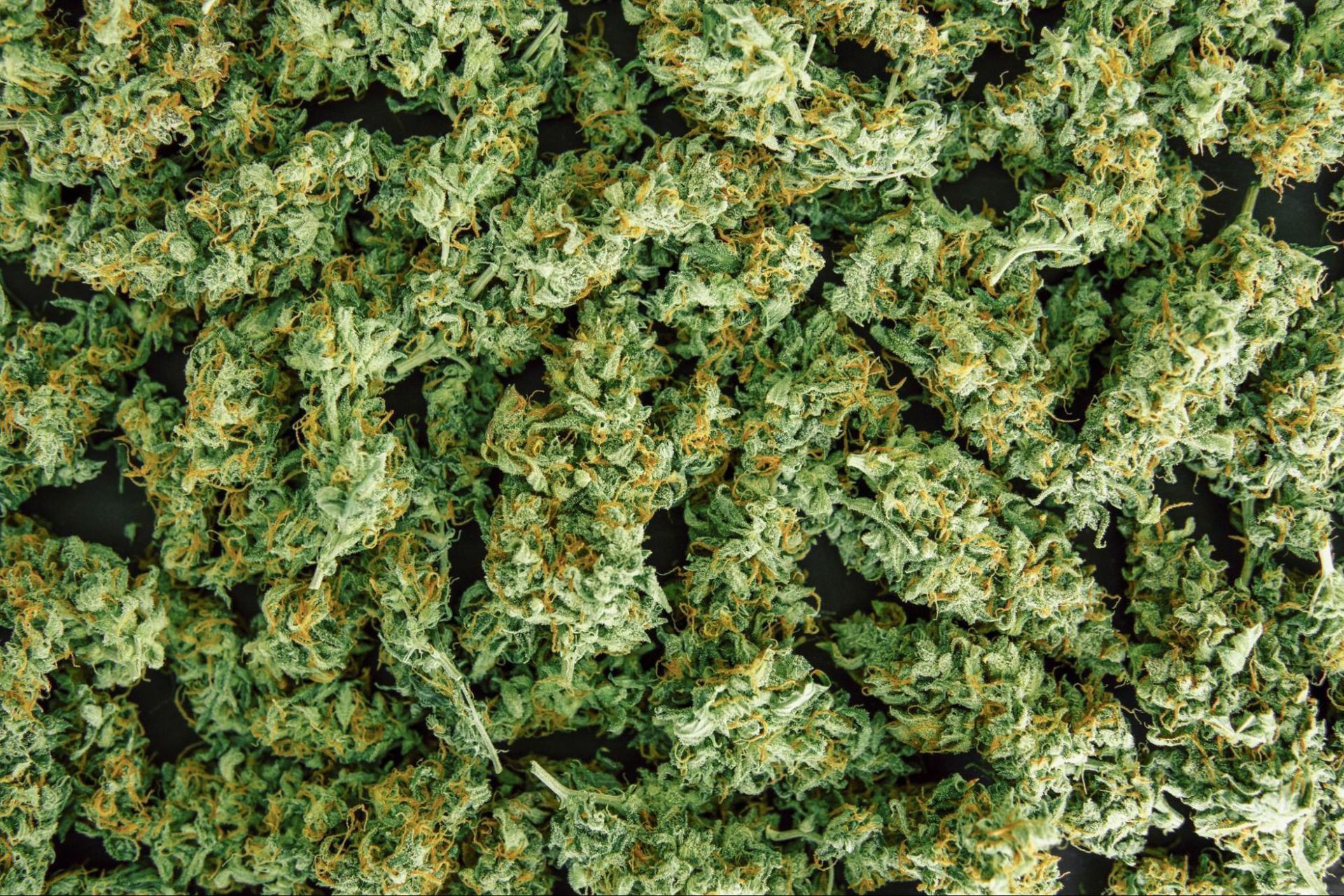The Montana Terpene Map | Elevated Cannabis Effects Guide
Discover the Montana Terpene Map, a local guide to reading cannabis terpene charts. Learn how aromas like pine, citrus, and spice reveal how each strain feels. From relaxation to focus, Elevated Montana helps you shop by effect, not just THC percentage.
Key points
- Definition: Terpenes are aromatic compounds that shape cannabis flavor, scent, and effect, the “mood map” behind every strain.
- Purpose: A terpene chart helps you shop by effect, not just THC %, connecting aromas to outcomes like focus, calm, or rest.
- Montana Advantage: Cold air and slow curing preserve terpenes longer, giving locally grown flower richer flavor and smoother effects.
- Testing & Transparency: Elevated partners with a certified Montana testing lab to verify terpene profiles and cannabinoid accuracy.
- Budtender Guidance: While we do have menus, our staff sits with you to match your goals, whether that’s sleep, focus, or stress relief.
Takeaway: When you know your terpenes, you know your experience. Elevated helps Montanans connect science, scent, and balance.
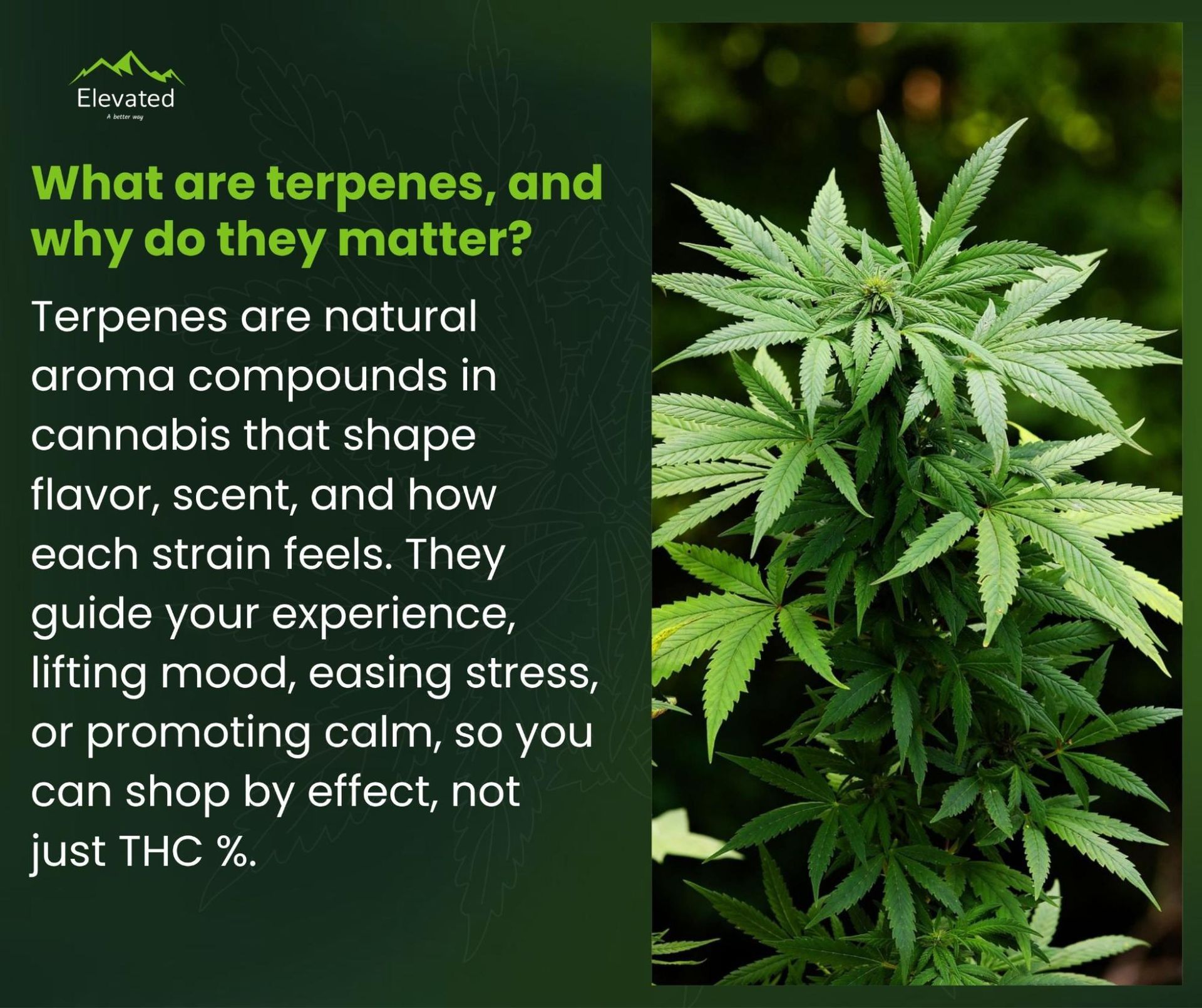
Picture this: it’s early February in Montana. You’ve just finished shoveling the driveway for the third time this week, your breath’s hanging in the air, and you’re wondering whether you need a hot toddy or a nap. You spark up a pre-roll instead, citrusy, crisp, just enough to take the edge off.
Halfway through, your shoulders drop, your mood lifts, and you catch yourself smiling at the snow.
That’s not the THC doing all the work. That’s terpenes.
Terpenes are the natural aromatic compounds that give cannabis its scent, flavor, and, more importantly, its personality. They’re the reason one strain makes you want to reorganize your garage while another has you melting into your couch with a grin.
A terpene chart is basically your map to those personalities. Think of it like a flavor compass, guiding you through the earthy, piney, citrusy world of cannabis so you can find the effects you actually want.
- Myrcene? Deep relaxation and that “Montana winter nap” feeling.
- Limonene? The pick-me-up you need on a gray morning.
- Pinene? A breath of mountain air that keeps your head clear.
Most people shop by THC percentage. But here’s the secret every good budtender knows: THC is just one voice in the choir.
A terpene chart shows how the whole harmony works, which scents and compounds combine to create calm, focus, laughter, or creativity.
So yeah, Montanans need terpene charts. Not because we love data (though we do), but because we know the land, and when the land grows this good, it deserves to be understood.
The Big Five Terpenes You’ll Actually Notice
Goal
Key Terpenes
What It Feels Like
Sleep / Calm
Myrcene, Linalool
Deep relaxation, body-heavy calm
Focus / Energy
Pinene, Limonene
Clear, creative, alert
Anxiety Relief
Caryophyllene, Linalool
Grounded calm without sedation
Pain / Body Relief
Caryophyllene, Humulene
Tension release, warm balance
Mood Boost / Social
Limonene, Ocimene
Bright, talkative, cheerful
If cannabis had a cast of characters, these five would be the regulars, each one with its own scent, story, and “why you reach for it” moment. They don’t just flavor your flower; they define how it feels when you light up, settle in, and let Montana’s quiet do the rest.
Myrcene: The Montana Winter Blanket
- Smells like: earthy, musky hops with a whisper of clove.
- Feels like: slipping into your comfiest hoodie after a long day.
- Common in: relaxing strains like Family Love and Marion Love.
Myrcene is the chill-out terpene. It’s the one that slows your racing thoughts, calms tight muscles, and makes winter nights more bearable. Perfect for those sub-zero evenings when the only thing louder than the wind is your to-do list.
Limonene: The Sunshine Saver
- Smells like: fresh-cut lemons and orange peel.
- Feels like: that first 60-degree day after weeks of gray skies.
- Common in: sativa-dominant strains that lift mood and focus.
Limonene is the mood-booster, bright, clean, and citrusy. It’s what you reach for when you need energy without jitters. Locals call it “the cabin fever cure.” A few puffs and suddenly, your chores feel like choices.
Pinene: The Glacier Breath
- Smells like: pine needles and cool mountain air.
- Feels like: taking a deep breath in the woods, clarity included.
- Common in: hybrids that support focus and creativity.
Pinene keeps your head clear and your thoughts sharp, like opening a window in your mind.
It’s great for daytime use, especially when you’ve got work to do or trails to explore. If cannabis could bottle Montana’s forests, this would be it.
Caryophyllene: The Quiet Strength
- Smells like: black pepper, clove, and a hint of spice.
- Feels like: a slow exhale after a long week.
- Common in: balanced strains for body relief and stress management.
Caryophyllene is unique; it’s the only terpene that directly interacts with your body’s CB2 receptors, which means it can soothe without sedation. It’s a favorite among veterans and active folks looking for relaxation that still keeps them grounded.
Linalool: The Lavender Peacekeeper
- Smells like: lavender, wildflowers, and calm itself.
- Feels like: a warm bath and a good book.
- Common in: indica-leaning strains for relaxation and sleep.
Linalool brings the exhale. It’s soft, floral, and deeply calming, the kind of terpene that turns down the volume on stress. Pair it with a Montana sunset and a cup of tea, and you’ll understand why balance beats buzz every time.
Reading the Chart Like a Local
Let’s be honest, most terpene charts look like something you’d see taped to a high school lab wall. Bars, numbers, percentages, Latin names… not exactly bedtime reading.
But once you know what you’re looking at, a terpene chart becomes your cheat sheet for how you’ll feel.
Each bar on that chart represents how much of a particular terpene shows up in a strain.
- Dominant terpenes (usually above 0.5%) are the “lead singers”; they define the aroma and the main effect.
- Secondary terpenes (around 0.2–0.4%) are the backup vocals, subtle, but they give depth and balance.
Here’s the trick: it’s not about finding one “best” terpene, it’s about seeing how they play together.
Budtender Tip: Finding your perfect strain is just like fine-tuning a playlist; it’s not only about what’s trending, it’s about discovering what works best for you.
For example, a strain high in Limonene and Pinene will likely feel bright, clear, and energizing, your perfect Saturday hike companion. But swap in Myrcene and Linalool, and suddenly it’s the chill, cozy-night-in combo.
Now here’s where it gets Montana-specific: our cold, dry climate acts like nature’s refrigerator.
The terpenes that make your flower smell so good, those delicate aromatic compounds, are volatile. They evaporate under heat and light.
In places like California, terpene content can fade fast. But in Montana, cool air helps preserve those molecules longer, giving our flower richer scent and smoother smoke.
It’s why Elevated’s cold-cured process matters. We slow-cure our flower in low-humidity environments to keep those terpenes intact, no boiling, no flash drying. Just patience, precision, and pure chemistry-meets-craft.
So when you’re looking at a terpene chart in one of our shops, think less like a scientist and more like a local.
Ask yourself:
- Do I want a strain that wakes me up or winds me down?
- Do I want to feel it in my head or in my body?
- Do I want to smell citrus, pine, or earth when I open that jar?
That’s your terpene chart decoded.
It’s not data for data’s sake, it’s a
Montana map for how you want to feel.
Montana’s Terpene Advantage
There’s something special about growing cannabis in Montana, and it’s not just the views.
Our state’s cold, dry climate naturally helps protect terpenes, the delicate aromatic molecules responsible for cannabis’s flavor and effects. Where warmer regions can lose 40–60% of their terpene content during drying, Montana’s cooler temperatures act like nature’s preservation chamber.
Here’s how it works:
- Lower humidity = slower drying. Instead of baking out aroma, our flower dries gently, letting terpenes stay intact.
- Cooler nights = stronger profiles. Temperature swings between day and night encourage the plant to produce thicker resin, the sticky layer where cannabinoids and terpenes live.
- Clean air and high altitude = fresher expression. Less moisture and fewer pollutants mean the plant can express its natural chemistry without interference.
That combination is why Montana-grown cannabis often smells and tastes richer than mass-produced flower from large-scale farms. You’re not just getting THC; you’re getting the full spectrum of flavor and effect that nature intended.
At Elevated, our cultivation and storage methods are built around protecting that chemistry:
- We cold-cure our flower to lock in terpenes.
- We store products in sealed, child-proof containers away from heat and light.
- We continually review lab data from certified testing facilities to track terpene stability over time.
It’s the kind of behind-the-scenes care you might never notice, until you open a jar and that first whiff hits you like mountain air after rain.
That freshness? That’s science and stewardship working together.
So when we talk about the Montana Terpene Advantage, we’re not just talking climate, we’re talking culture.
Our growers respect the land. Our budtenders translate the data. And our customers get cannabis that actually feels like where it comes from.
Stay Elevated: The Montana Way

In Montana, cannabis isn’t just something you buy, it’s something you share. Every visit to Elevated starts with a conversation, not a transaction. Because here, we believe cannabis should help you feel connected. To yourself, your neighbors, and the land we all love.
Stop by your nearest Elevated dispensary and discover what it means to Stay Elevated.
Grounded in Montana, guided by community.
FAQ
How do I read a terpene chart if I don’t know chemistry?
Focus on the top two or three terpenes; they set the tone for how you’ll feel. Think of it like checking a weather forecast for your mood.
Do Montana’s cold climates affect terpene potency?
Yes. Cool air and low humidity help preserve delicate terpenes, keeping flavors and effects fresher longer.
Which terpenes work best for sleep?
Myrcene and Linalool. They’re relaxing, soothing, and perfect for winding down during long winter nights.
Can edibles still contain active terpenes after baking?
Yes, when made with full-spectrum extracts, some terpenes survive heat. Elevated’s in-house edibles keep those compounds intact for a balanced, body-first effect.
Why does the same strain sometimes feel different?
Terpene levels can vary by harvest, curing method, and storage. Even small changes in humidity or light can alter a strain’s aroma and effect.
How long do terpenes last in storage?
When sealed, cool, and away from light, most terpenes stay potent for up to six months. Elevated’s cold-cured process helps extend that even longer.
What’s a safe terpene level for beginners?
Look for moderate profiles, dominant terpenes around 0.5% to 1%. Balanced blends tend to feel smoother and more predictable.
Disclaimer
The statements made regarding these products have not been evaluated by the Food and Drug Administration. The efficacy of these products has not been confirmed by FDA-approved research. These products are not intended to diagnose, treat, cure, or prevent any disease. All information presented here is not meant as a substitute for or alternative to information from healthcare practitioners. Please consult your healthcare professional about potential interactions or other possible complications before using any product.
References
- Booth, J. K., & Bohlmann, J. (2019). Terpenes in Cannabis sativa – From plant genome to humans. Plant Science, 284, 67–72.
- Holmes, M. (2023). Cannabis terpenes decoded: What scent says about your high. Scientific American.
- Russo, E. (2011). Taming THC: Potential cannabis synergy and phytocannabinoid-terpenoid entourage effects. British Journal of Pharmacology, 163(7), 1344–1364.
- Sydney University. (2021). Terpene preservation in cold climates and its role in cannabis quality. Scientific Reports.
- Labstat International. (2022). Comparative analysis of terpene degradation in different cannabis curing conditions. Journal of Cannabis Testing Standards.

